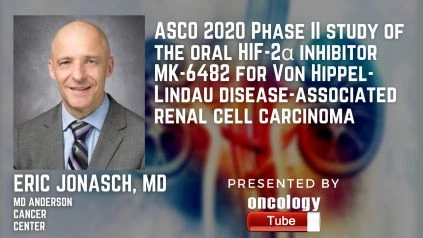Eric Jonasch, MD The University of Texas MD Anderson Cancer Center ASCO 2020 Phase II study of the oral HIF-2α inhibitor MK-6482 for Von Hippel-Lindau disease-associated renal cell carcinoma.
Context:
Several cancers, including clear renal cell carcinoma (ccRCC), are at risk in patients (pts) with Von Hippel-Lindau disease (VHL). VHL inactivation results in the constitutive activation of the transcription factor of HIF-2 aa, which drives the development of the tumor. In a phase 1/2 trial, MK-6482, a potent, selective, small-molecule HIF-2 alpha inhibitor, has shown favorable safety and antitumor activity. Initial findings of phase 2 open-label analysis of MK-6482 for the treatment of VHL-associated ccRCC (NCT03401788) are provided.
Methodology:
Adult pts with pathogenic germline VHL heterogeneity, detectable localized/nonmetastatic ccRCC, no previous systemic anticancer treatment, and 0/1 ECOG PS received MK-6482 120 mg once daily orally before development, unacceptable toxicity, or withdrawal decision by the investigator/pt. The primary endpoint was the independent radiology review ORR of VHL-associated ccRCC tumors per RECIST v1.1. DOR, time to answer (TTR), PFS, and protection and tolerability were the secondary end-points.
Outcomes:
61 pts were enrolled as of December 6, 2019; the median (range) age was 41 years (19-66) and most pts were male (52.5 percent) and had 0 (82.0 percent) ECOG PS. CNS hemangioblastomas (80.3 percent) and pancreatic lesions (50.8 percent) were the most common lesions outside of the kidney (non-RCC tumors). The median (range) period of therapy was 9.9 months (1.9-18.2) and 95.1% of pts are still on therapy. Discontinuation of three pts (AE, n = 1; death [fentanyl toxicity], n = 1; judgment of pt, n = 1). There were 17 confirmed answers (ORR, 27.9 percent [95 percent CI, 17.1-40.8 percent]), and 8 (13.1 percent) unconfirmed answers (documented at 1 time and to be confirmed at a later time); all responses were PRs. Of the 61 pts, the size of target lesions decreased by 53 (86.9 percent). Median (range) DOR was not achieved (2.1-9.0 mo) in 17 pts with confirmed response and median (range) TTR was 5.5 mo (2.7-14.0) in 17 pts with a confirmed response. In CNS, retinal, and pancreatic lesions, responses were also noted. There was no median PFS; the 12-mo PFS figure was 98.3 percent. Treatment-related AEs (TRAEs) occurred in 96.7% of pts, mainly grade 1 (44.3%) or grade 2 (42.6%) and mostly anemia (83.6%; considered an on-target-toxicity), exhaustion (49.2%), and dizziness (21.3%). Grade 3 TRAEs, mainly exhaustion (4.9 percent) and anemia (3.3 percent), occurred in 9.8 percent of pts. No grade 4 or 5 TRAEs were present. One pt was discontinued due to dizziness (TRAE).
Findings:Â
In pts with VHL-associated ccRCC and responses in other VHL-related lesions, MK-6482 showed promising efficacy and tolerability. These data support further investigations into the disease of MK-6482 in VHL. Data on clinical trials: NCT03401788.

